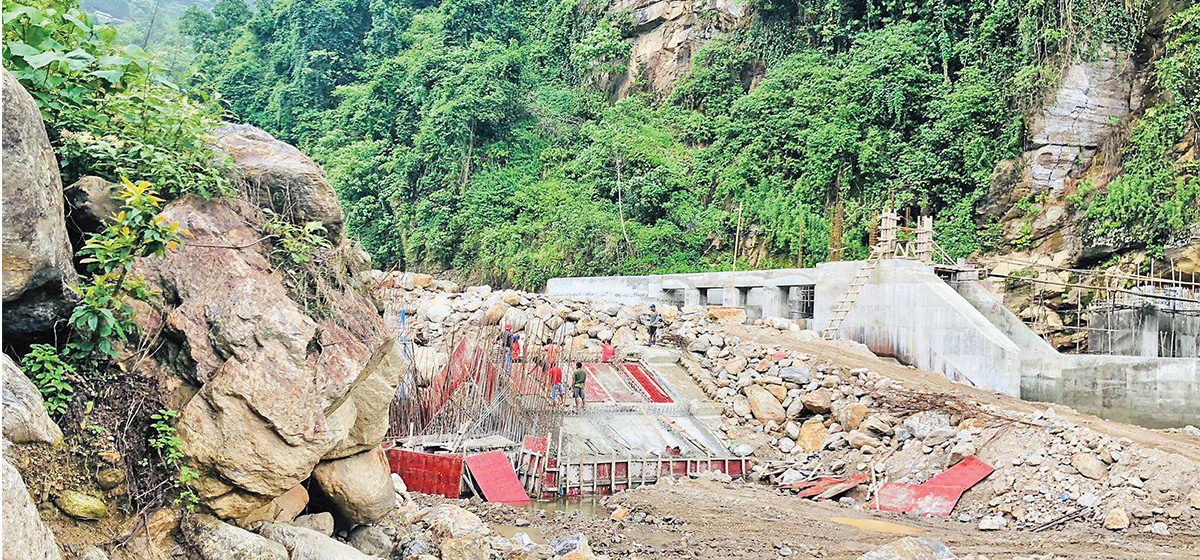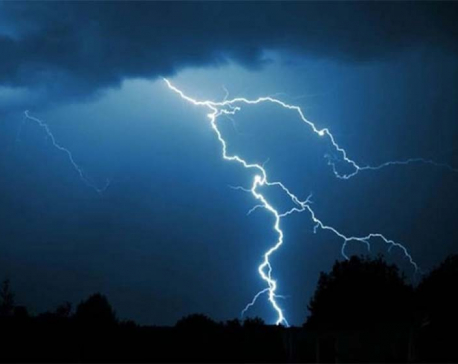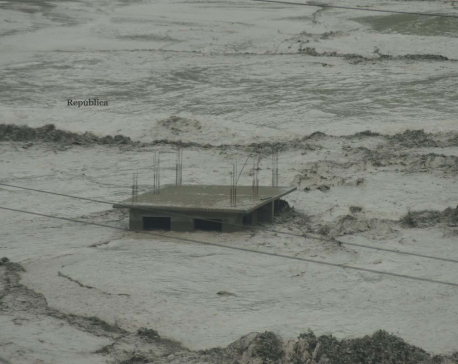
OR
Lack of disaster preparedness causing severe damages to hydropower projects in Nepal
Published On: January 27, 2024 09:50 PM NPT By: Himal Lamsal

Experts suggest building structures that are resilient to natural disasters and climate change
KATHMANDU, Jan 27: On June 14, 2023, the employees working in the under-construction Super Hewakhola hydropower project at Chainpur, Sankhuwasabha, went to sleep after having dinner. The heavy flood in Hewakhola at around 9:30 PM not only washed away 18 workers along with their tents built on the river bank, but also damaged more than half a dozen structures of the project.
Keshav Aryal, the director of Ishan Construction Pvt Ltd, who was responsible for the construction of the civil engineering structures of the Super Hewa Khola hydroelectric project, had dinner with the same workers just before the flood. Fortunately, Aryal survived as he left the site an hour and a half before the disaster struck. Of the 18 individuals working on the project, only four bodies were recovered, leaving others unaccounted for.
“When the flood hit, the ground shook just like the 2015 earthquake. The flood washed away the big boulders and trees," Aryal said, remembering the moment of the flood. "Due to the sudden flash flood, those who were sleeping in the tents didn't even get a chance to escape. They were swept away by the flood as we watched them helplessly,” he added.
Harka Bahadur Tamang, chairman of Super Hewa Khola Power Company Limited, said that the floods in Hewa Khola caused human casualties as well as substantial physical damage. "We had never imagined that the flood would hit and cause such great damage," he said.
According to Chairman Tamang, the flood damaged more than half a dozen physical structures such as the project's dam, power house, and water storage pond, resulting in a loss of Rs 220 million. He estimates that it will require Rs 500 million to rebuild the structure damaged by the flood.
The government is planning to raise the living standards of the people by producing hydropower and increasing consumption of electricity in the country and also by selling surplus energy abroad. But questions have been raised about the sustainability and reliability of this plan of the government due to climate change triggering an unexpected pattern of rainfall.
In recent years, heavy floods and landslides have caused loss of lives in various parts of the country due to unseasonal rainfall. This has also affected hydropower projects.
In Eastern Nepal, the continuous floods from June 13, 2023 to June 22 caused damage to 11 hydropower projects with a total capacity of 107.54 megawatts.
The data released recently by Independent Power Producers Association Nepal (IPPAN) shows that 20 hydropower projects under construction in Sankhuwasabha, Bhojpur, Panchthar, Taplejung with a total capacity of 369.33 megawatts have suffered damages due to floods.
According to IPPAN, the flood in eastern Nepal caused damage to the physical structure of 31 hydropower projects, causing a loss of more than Rs 8 billion.
Heavy rain before onset of monsoon
Four districts of eastern Nepal experienced heavy rainfall before the onset of monsoon in 2023. The Department of Hydrology and Meteorology had said that monsoon will enter Nepal from June 14, 2023. But in eastern Nepal, there was heavy rainfall before the onset of monsoon. Spokesperson for the department, Sunil Pokharel, says that the heavy rainfall in eastern Nepal triggered landslides.
Arun valley of Sankhuwasabha also has a special weather naturally. There is a different type of rain than other parts of Nepal, he said, "Due to climate change, there is a change in the nature of rain in recent times. Due to this, we are wondering whether the pattern of rainfall has been altered. But it is difficult to confirm it scientifically,” he added.
The department's weather radar shows rainfall exceeding 60/70 mm per hour during floods at various places of Sankhuwasabha. A record 141.6 mm of rain was recorded at Num station of Sankhuwasabha on June 13.
A record rainfall of 49.4 mm was also witnessed at Phidhim station in Panchthar. Num station in Sankhuwasabha recorded 50.2 mm of rain on June 14, 22 mm on June 15 and 123 mm on June 16.
On June 17, it rained very less i.e, 9 mm. It rained 111.4 mm on June 18 and 387.4 mm on June 19. A record of 183.6 mm of rain was recorded in the two hours of midnight on June 20. Water Resources Engineer Narendraman Shakya says that there has been a lot of damage to hydropower projects in eastern Nepal due to heavy rains.
"Floods in the eastern region appear to have been triggered due to sudden rainfall," he said, "It is not a good sign to have about 400 millimeters of rain in one day."
In general, in a place with topography like Nepal, 100 mm of rain in a period of half an hour or an hour is considered as heavy rain. According to the Dharan-based water and weather office, 388.3 mm of rain fell on June 11, 1997 in Sankhuwasabha.
Similarly, there is a record of 394.5 mm of rain on April 22, 2001. According to the office, 387.4 mm of rain fell in Sankhuwasabha on June 5, according to Num station's record.
Senior climate change expert Arun Bhakta Shrestha says that due to climate change, floods and landslides have been occurring more rapidly in recent years. "Earlier, there were no frequent occurrences of floods and landslides in Nepal," he said, adding, "Now, due to climate change, the possibility of sudden and frequent floods and landslides has increased rapidly."
He said there are enough reasons to believe that the current floods and landslides in Nepal are due to climate change. In the past, there was no heavy rainfall in the high mountainous areas. But now, even in the mountainous areas, 100 milliliters of rainfall occur in a single day. This is not a natural phenomenon here," he said. "In recent years, heavy rains have started to take place even in areas where it used to snow."
He said that the country is facing problems in interpreting and analyzing the patterns of rainfall scientifically because Nepal does not have enough instruments to measure rainfall.
On June 15, 2021, floods damaged 26 hydropower projects in the Madi Corridor, Dordi Corridor and Marsyangdi Corridor. At that time, 10 hydropower projects in operation and 16 under construction projects were damaged. It was estimated that the damage was more than Rs 5 billion.
Before the flood on June 15, 2021, the construction of the 44 MW capacity Super Madi hydropower project in Kaski district was 95 percent completed. However, due to the severe flood that occurred on June 15 on Madi river, the construction period of the project was extended and the financial burden also increased.
The initial cost estimate of the Super Madi hydropower project was Rs 7.47 billion, but as the construction period was prolonged, its cost reached Rs 8.70 billion. Pushpajyoti Dhungana, the owner of the Super Madi Hydropower Project, says that hydropower projects are facing serious challenges due to climate change.
"Hydropower projects built at the cost of billions of rupees are being hit by floods," Dhungana said. Due to the unexpected flood, the cost of the Super Madi project, which was about to be completed, increased by Rs 540 million and the construction period was also delayed by eight months. In June 2021, floods damaged not only the Madi basin, but also the hydropower projects of the Dordikhola basin. Super Dordi 'B' hydropower project of 54 MW capacity, Dordi 1 hydropower project of 12 MW capacity were also damaged by the flood.
Extended construction periods lead to a rise in financial burdens
By the end of June 2019, 95 percent of works of the 25 MW capacity Upper Dordi 'A' hydropower project had been completed. The project was set to be operational later the same year. But on July 24, 2019 the severe flood in Dordi River caused damage to the physical structure of the 25 MW Dordi 'A' hydropower project in Dordi Rural Municipality of Lamjung.
A total of six workers who were engaged in the construction of the project died after being swept away by the flood. The condition of four people swept away by the flood is still unknown. First, the damaged structure could not be rebuilt after being destroyed by the flood, and the flood that occurred on June 15, 2021 caused further damage to the dam area of the project. Due to the flood, the project started producing electricity commercially only 34 months after the scheduled time, i.e. from December 3, 2022. The cost of the project (initial cost Rs 3.96 billion) increased to Rs 6.65 billion when the construction period of the project was extended due to floods.
Water resources engineer Shakya says that the structure of the hydropower project should be made in such a way that it can withstand the effects of floods and landslides and climate change. Watershed expert Madhukar Upadhyay says that the project should be designed and constructed keeping in mind the risk of unexpected rainfall and landslides.
He suggests, "Government agencies should establish a regulatory system when issuing survey permits for hydropower projects, during construction, and at the handover phase."
Director General of the Department of Electricity Development, Chiranjeevi Chataut, says that since Nepal is a country with a high risk of climate change and floods, those issues should be taken into consideration while building the structure of hydropower projects.
Now, it is crucial to build structures that are resilient to natural disasters and climate change.
Director General Chataut said that the government is actively working to establish international level policies and rules in the construction of hydropower projects.
Anil Pokharel, chief executive of the National Disaster Risk Reduction and Management Authority, said that monsoon floods are causing major damage to the infrastructure of large-scale hydropower projects. He said that although climate change is the cause of various disasters in Nepal, the government has not been able to claim the amount for damages and losses due to the lack of scientific studies and research.
Tamang, chairman of the Super Hewa Khola Power Company Limited, says caution should be taken when constructing hydropower projects in the future considering the risks of monsoon floods.
You May Like This

HIDCL invests Rs 21.2 billion in 18 hydropower projects
KATHMANDU, July 13: Hydroelectricity Investment and Development Company Ltd. (HIDCL) has successfully invested Rs 21.2 billion in 18 hydropower projects... Read More...

Five killed, 43 injured in lightning strikes in a month
KATHMANDU, May 16: Forty-four incidents of lightning were reported in the country in a month and they resulted in the... Read More...

Floods and landslides damages 26 hydropower projects, multiple road sections
KATHMANDU, June 17: The floods and landslides triggered by incessant rainfall have caused physical damage of around Rs 3 billion.... Read More...











Just In
- Challenges Confronting the New Coalition
- NRB introduces cautiously flexible measures to address ongoing slowdown in various economic sectors
- Forced Covid-19 cremations: is it too late for redemption?
- NRB to provide collateral-free loans to foreign employment seekers
- NEB to publish Grade 12 results next week
- Body handover begins; Relatives remain dissatisfied with insurance, compensation amount
- NC defers its plan to join Koshi govt
- NRB to review microfinance loan interest rate







Leave A Comment